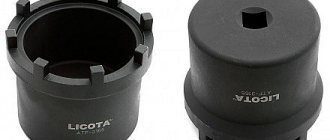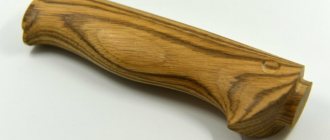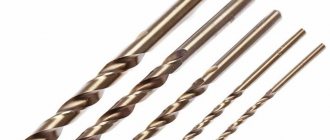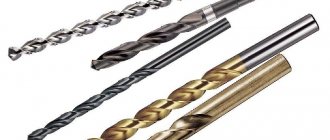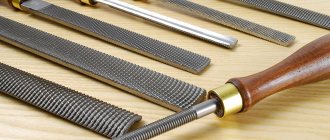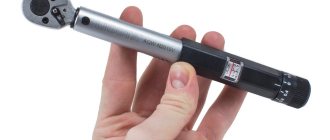Different types of tools are used for different purposes, including an axe.
The purpose of the ax varies depending on the type.
It will also have different parameters, sizes and shapes.
To choose the right tool for a specific job, it is worth studying its types.
The main components are the ax handle and the metal part, which has a blade and a butt.
Main types of axes
Each type of ax should be used only for its individual purpose.
Tools differ not only in size, but also in parameters, shape, and method of sharpening. Globally, axes can be divided into 3 large groups:
- Household.
- Special purpose axes.
- Combat.
Household axes
Ax for chopping.
In the household, an ax is most often used for chopping wood or for carpentry work. This is an indispensable tool in a private home or country house.
The cost is usually low. The tool itself is universal, the ax head is made of high-quality steel, sharpening is 50 degrees.
For felling forest
The tool for felling trees is the largest axe, with an ax handle of at least 90 centimeters and weighing more than three kilograms. Such a large weight of the tool is necessary to increase the impact force.
The work is carried out exclusively with two hands, for a strong and reliable fixation of the object. Using such an ax for other purposes is difficult and unsafe.
Large ax for felling wood.
Plotnitsky
A carpenter's or joiner's ax is a tool with a rounded, sharpened head, used on construction sites during the construction of log houses. To prevent the head from getting stuck in the tree, sharpening occurs at an angle of 35 degrees. The length is no more than 40 centimeters, the weight of the product is no more than one and a half kilograms.
Carpenter's axe.
Wood splitter
A heavy tool for chopping wood is called a cleaver. Its weight is about three kilograms, and sometimes five. The ax handle is large and long - for working with two hands.
A sledge hammer is used to split large logs. It is not sharpened, but the heavy head allows it to cope with a large tree. The ax handle is also impressive – more than 80 centimeters. Large cleaving axe.
Bearded Ax
The bearded ax was used in old times as a weapon and household tool. Currently used as decoration. There is a modern modification of this ax with an additional “tongue” on the ax handle.
Hog axe.
For chopping meat
To chop bones and beat off meat, an ax with a wide head and a short ax is used. This tool is convenient for delivering precise blows. Most often, a hatchet for chopping meat is made of stainless steel. The weapon has a considerable weight and is sharpened at an acute angle for convenient cutting.
An ax for chopping meat.
Special axes
In addition to the main types, there are specific modifications used for specific cases:
- An ice ax is a specific tool for cutting ice.
- An army or sapper ax is a special type, the peculiarity of which is the weapon’s light weight and small size. Comes complete with a carrying case.
- One-handed roofing tool is a special tool used on construction sites when arranging the roof. The peculiarity of such a tool is the appearance of the head: one side is a narrow sharpened blade, the butt is a hammer.
- A throwing hatchet is classified as a combat, hunting or sports weapon. Currently, it is more often used as decorative attributes in the interior.
- A pickaxe is a tool for working stone or when working to extract precious minerals.
- An adze is an unusually shaped tool used to cut grooves in wood. Usually used by builders when constructing a log house.
Throwing tomahawk.
Hiking (tourist)
A hiking tool should be lightweight, convenient, versatile and compact. The marching ax has these characteristics. They can easily chop wood and meat, hammer a peg, and clear branches of bark.
This model usually has a rounded head for safe transportation in a bag.
A type of camping ax is a tourist one. It is smaller in size and has a similar appearance to the army one. The kit always includes a protective case.
Compact travel axe.
Hunting
Hunting axe.
There are a great many varieties of hunting axes. They are used both for chopping firewood and for butchering animal carcasses and skin.
The weight of the gun is no more than 750 grams, and the maximum length does not exceed 40 centimeters. These sizes make it much easier to use. They are made of all-metal, and the ax handle is supplemented with a special rubber insert.
Firefighter
Firefighters and rescuers often use a fire ax when extinguishing fires. It is all-metal, with rubber pads on the ax handle to protect the skin of your hands from burns. The weight of the product is no more than two kilograms, the head is blunt, as it is used to help in entering a room.
According to the regulations, such an ax should be at any enterprise, on the fire panel. It is always colored red.
Main characteristics
The products differ from each other in characteristics, which include the following:
• Tool weight
Depending on the type and purpose of the weapon, the weight varies.
For splitting firewood or cutting wood, a heavier option is required, while for precision work, you will need a product that is small and easy to use with one hand.
• Blade shape and quality of steel for the ax
The higher quality the raw materials are used, the longer the tool will last.
It will also remain sharp longer and will not experience chips or mechanical damage.
• What shape is the ax handle made of?
Size and shape depend on operational purposes.
It is important that the handle fits comfortably in the hand and does not have any nicks or irregularities.
• The method of attachment to the ax handle affects the service life and ease of use
An important part is the handle, which is made of different lengths depending on use.
In order to get good impact force, you need to take a tool with an extended handle.
A more accurate ax with a wooden hand will be if it is short.
Lumberjacks use an ax handle in the range of 70-90 cm in length.
An ax with a cranked handle is suitable for cutting branches.
It is more convenient to hew with a tool with a short handle.
The ax handle must be well processed and carefully polished.
Ax device
The ax consists of two main parts:
- head;
- handle (axe).
The head, in turn, consists of:
- canvases;
- toe and heel (also called heel);
- blades;
- butt;
- cheeks and beards.
The ax handle can be divided into:
- eye;
- body;
- throat;
- tail.
The design of the instrument has not changed over time. The characteristics of individual elements influence the quality and method of work. For different purposes, you should select the appropriate ax parameters.
Ax device.
Working part
The working, metal part of the ax is called the head by professionals. One side is a sharp blade, the other is a butt. The top corner of the blade is the toe, and the bottom is the heel. In some models, the cheeks are highlighted - this is the side surface of the canvas.
The most important parameter of the head is the hardness of the metal. Made from medium-alloy tool steel that has undergone heat treatment.
The working part comes in three types:
- Extended. Designed for cutting wood or logs. A similar shape is found in felling or construction axes.
- Average. Used for cutting branches, trimming logs, cutting grooves. Gardening, hiking and carpentry axes are equipped with this type of head.
- Narrow. Used for chopping firewood, sharpening wedges, and preparing wood chips. An ax with a narrow working part is a cleaver.
The edge of the blade can be straight or rounded. In addition to the shape, the degree of sharpening is important. It all depends on the purpose of the tool.
Toporische
The ax handle or ax handle is the part that must withstand the impact and vibration after it.
- If we are talking about a wooden handle, then it is recommended to choose birch. It is light and stable. In addition to birch, species such as oak and ash are preferred.
- An important parameter for a wooden ax handle is the location of the fibers. It must be longitudinal.
- The ax handle should not contain any defects in the form of knots, cracks, or the like. Darkening from dampness or slight drying out is allowed.
- The most reliable, according to experts, are metal axes. Typically, this is a reliable all-metal construction. The handle is additionally rubberized, which ensures a secure grip.
- Many European manufacturers produce axes with fiberglass handles.
- Fiberglass has unique strength: it is not subject to rotting, corrosion, does not deform under mechanical stress, and does not react to aggressive environments. An ax with such an ax is easy to use - in case of a large impact, the material reduces the impact of vibration on the worker’s hands.
Battle axe.
How is it different from usual?
For example, carpenter's axes differ from taiga axes in the shape of the blade and the length of the handle.
The tasks that tools are supposed to perform are the opposite. With a carpenter's ax you need to cut as accurately as possible. The workers here are not known for their haste, since the main thing in the course of such work is to avoid mistakes. Commercial products or splitting axes perform another function - they quickly and deeply cut wood. The shape of the ax is made in such a way that it is possible to fell a tree faster than with a carpenter's tool with equal effort expended.
The carpenter's versions do not have a powerful groove - a protrusion under the ax handle, which prevents the handle from breaking due to vibration. This protrusion absorbs about 50% of the load. However, this groove will not save the handle if it breaks on a block. The carpenter's ax does not have a wide front. The blade of the commercial version is made at an angle. This allows the worker to use the tool as a cleaver. You just need to concentrate your energy on the right shot.
The ax handles of carpentry and trade tools differ in the angle of inclination. The first option has a smooth downward angle. The protruding edge of the ax is visible visually. The fishing gear simply does not have it. This very angle creates strong vibrations.
In addition to the blade, the carpenter's version also differs in its ax handle. Here it has an ovoid cross-section. The first half of the carpentry tool should not be very heavy and thin, otherwise it will quickly break. Aspen handles are considered to be of high quality. A good workpiece should be strong and light. It is recommended to treat homemade options not with varnish, but with drying oil. The varnished ones will slide and be cold.
Cleaver ax
This type of ax is designed for one purpose - splitting logs or cuttings of trunks when cutting firewood. The cleaver has a peculiar shape of a metal blade. In appearance, it resembles a drop from the end. That is, the blade of this ax expands very sharply to the place where the ax handle is inserted into the metal part. This was done so that during the process of chopping firewood, the blade works in the form of a wedge, pushing the wood fibers to the side, splitting the stump.
The cleaver is usually quite heavy, since the impact on the wood is not due to a sharp blow, but due to the force of inertia. To split a tree, it is enough to sharply lower the cleaver onto the stump, which, taking into account the mass of the ax, will split it quite easily. Cleavers usually have a long handle in order to increase the force of the blow. The handle of the cleaver is usually made of hard and tough wood: birch, maple, elm.
It is not recommended to use oak as a material for an axe. Due to its increased strength during operation, such an ax handle will “dry your hands.” That is, most of the energy from the blow will be transferred to your hands, due to which you will quickly get tired. If you are cutting stumps with a large number of knots, along with the cleaver you may also need wooden wedges that are hammered into the tree until it splits.
When choosing this tool in a store, we do not recommend being fooled by shiny, chrome-plated models with a plastic axe. A good old cleaver with a wooden ax and a forged metal part is better suited for chopping firewood, and is also significantly cheaper.
How to choose an ax
The modification of a tool directly depends on the purpose of its use. The choice is made according to certain parameters:
- head shape and size;
- sharpening angle;
- length of the ax;
- ax handle material;
- comfortable ergonomic shape;
- weight (a heavy instrument is more powerful, a light one is more accurate);
- additional equipment (case).
Experts recommend purchasing different axes for different types of work:
- For processing wood, medium-sized equipment with a wooden ax is suitable.
- For a tourist gathering you need a durable and compact model.
- A heavy cleaver is ideal for chopping wood.
The variety of manufacturing companies often confuses the buyer when purchasing:
- The best among similar companies with centuries of experience are considered to be companies from Finland. Finnish hand tools have always been famous for their durability and resistance to various climatic conditions. Famous Finnish brands produce expensive models, but these are always reliable tools with the highest performance qualities.
- Manufacturers from Sweden and German companies produce products in the mid-price segment. Their products are high quality, lightweight, durable, reliable and will help out in any situation.
- There are many conscientious companies in Russia that produce universal tools for woodworking, tourist axes and more. The low and medium price category makes such products popular in the household market.
- Chinese firms have the lowest price. You should make a choice among such companies very responsibly, since there is a high probability of buying a fake.
For work, it is better to purchase several axes.
How to use
When working, you must strictly observe safety precautions. In addition, it is important to use the tool only for its intended purpose.
So, the rules of woodworking are as follows:
- When cutting down a short tree, you first need to remove the branches and attach a strong rope to the top, tilting it in the direction where the tree should fall. The cutting is carried out to the middle of the trunk on the side of the expected fall. Then they are sawed through with a saw.
- When chopping wood on a log, first of all, you should remove the branches in the direction from the bottom to the top.
- Logs are cut using a support placed under the impact site. First the blows are vertical, the next ones are at an angle of 40 degrees. When working, the log is rotated, uniformly approaching the middle.
- To hew a board, one end is fixed and hewn from top to bottom.
Rule 2: pay attention to the ax handle
First you need to decide which material will be preferable. Traditionally, the ax of the tool was made of wood, and today this material is the most popular. Most often, birch, oak, ash and other dense woods are used, which produce an elastic handle that can absorb shock.
When choosing an ax with a wooden hatchet, you need to pay attention to the direction of the fibers - they should run along. There should be no defects in the array, for example, traces of knots or cracks
This is a guarantee that the handle will withstand strong impacts and will not crack. The only drawback of such axes is that the handle may darken from dampness or dry out over time. Therefore, if you choose an ax to work in such conditions, it is better to give preference to a model with a handle treated with paint or varnish.
Metal axes are also available on the hand tool market. As a rule, the ax handle with the blade has an all-metal construction, so these products are very reliable. For a comfortable grip, the handle is equipped with a rubberized pad that prevents your hand from slipping during operation. But such instruments are slightly heavier than those with a wooden handle.
As for practical benefits, the use of fiberglass for the manufacture of impact instruments significantly improves the performance of products. In the event of a strong impact, such an ax will not only withstand a large mechanical load, but will also reduce the impact of vibration on the user’s hands. To prevent your hand from slipping, the handle may have a solid rubber pad or several corrugated rubber inserts.
When choosing an ax, also pay attention to the length of the handle. For tourist hatchets it is short - about 20 cm, which reduces the weight and makes the tool compact
It does not take up much space in your backpack, and can also be hung on your belt. For devices for chopping trees or splitting firewood, the length of the ax is from 35 to 50 cm. This ensures a good swing and allows you to strike with great force.
Expert advice: the optimal length of the ax is one that is 6-7 times the width of the butt. This ratio ensures that the swing is comfortable and that the design of the instrument can withstand heavy impacts.
In addition to strength and reliability, the ax handle should also be comfortable. It depends on its shape. Most tools have a curved handle to give your hand a secure grip.
Make sure that the handle is not too curved, otherwise this area will be most vulnerable to impact and the ax handle may crack.
The end of the handle is usually slightly widened so that the tool does not fall out of the hand if it accidentally slips. An additional guarantee that the ax will not fall out will be provided by the presence of a hole in the handle for threading a lace. By securing your wrist in the loop, you will be more confident that the risk of injury is minimal while working.
Rules of care
In order for an ax to serve for a long time and efficiently, it should be properly and regularly maintained. The simplest professional tips for caring for your instrument are as follows:
- To prevent the tool from becoming covered with rust and corrosion, it should be treated with machine oil.
- The tool should be stored in a specially designated place, preferably in a case.
- Timely sharpening is a mandatory procedure.
- Regularly check the fixation of the head on the ax handle.
- Mandatory replacement of the ax handle if it breaks or if any defect is detected.
Best travel ax
Typically very light weight and compact in size. The blade of such a hatchet may have semicircular edges to make it easier to carry in a backpack
Most often, manufacturers pay special attention to the design of such an instrument and always provide it with a case.
Main advantages:
- a light weight;
- The instrument is equipped with a protective cover;
- a sharp blade that allows you to use the tool as a knife;
- handle length no more than 50 cm.
Minuses:
- high price (usually significantly above average);
- rust on the blade (after long use the blade becomes covered with a layer of rust, especially after being in the case for a long time);
- not suitable for cutting firewood and logs.
Best models:
- Geter Gator II. It easily wins in the “price-quality” category, it has a low cost, compact size and a comfortable fiberglass handle. The Geter Gator II meets all the requirements for a touring tool.
- Expedition NV-040. It can rightfully be called the most functional among all its brothers. The manufacturer has equipped it with a straight blade and a bright handle to make it easier to find the tool in the forest.
The light weight, just over a kilogram, will not weigh down your travel backpack, and the plastic handle with a rubber lining will make the ax as safe as possible when chopping branches.
STAYER Taiga. The lightest of the touring models. It has a rounded blade and weighs 800 grams. It has a wooden handle, which is not very convenient during long hiking trips.
How to properly place an ax on an ax handle
Much depends in further work on the correct attachment of the ax to the ax handle.
You can do this yourself in several ways:
- using welding;
- production of tools from solid metal blanks;
- gluing with epoxy glue with curing in a special chamber;
- planting and wedging.
All-metal and welded options are the most reliable, however, such a tool is heavy and has a harsh feedback that the hand feels when working.
The glued version is produced in a factory, while the ax handle is made of polymer materials.
It is impossible to make such a tool at home.
Mounting an ax blade on a wooden handle is easiest to do yourself, but you need to know certain nuances and technology.
First, you need to select a handle for the future tool, fit it to the eye of the blade, prepare the wedges, and make several cuts on the ax handle.
Thread the handle through the eyelet so that it is flush with the top edge or protrudes slightly beyond it.
Next, you should pay attention to how to wedge the ax handle.
A wedge is inserted into the cut and driven into the wood using a hammer.
The same manipulations are carried out with the remaining wedges.
The upper part of the instrument is cleaned, sometimes filled with glue and painted.
Be sure to test the finished product: everything should hold tightly, not dangle and be well cushioned.
What is an axe?
A tool with a short shaft and a blade sharpened on one side, which is located along the handle - this is an ax. Craftsmen use it as a tool for working with wood, athletes use it for throwing, and it is also a common type of bladed weapon. There is still debate about the origin of the name of the axe. A similar word existed among the Slavs, Iranians, and Finns. Other names for the weapon are also known: axe, argun. There are several options for attaching a blade to the shaft, the most common is installing it in an eye and fastening it with a wedge.
What does an ax look like?
Even a child can distinguish an ax from other tools; its structure is primitive. Everyone knows what an ax looks like; it only has three parts. Axes, which are familiar to everyone, have a curved wooden handle - a grip; in modern models of axes it can be made of other materials - metal, plastic, fiberglass. A heavy, sharpened metal blade is attached to the grip. The wedge is the third important element of any good ax; the quality of fastening the blade to the grip depends on it. Other parts of the tool are:
- butt;
- tail;
- eye;
- cheek;
- sock;
- heel;
- goatee;
- canvas.
Sharpening rules
For an ax to function properly, it must be sharpened regularly. Working with a blunt instrument is difficult and sometimes dangerous. However, there are certain models that do not need sharpening, for example, a cleaver or a fire ax.
When sharpening, several rules should be followed:
- Correct choice of the correct sharpening angle.
- To prevent the steel from softening, it is necessary to avoid overheating the head when sharpening.
- When sharpening on an electric sharpener, it is necessary to adjust the minimum speed and select the most even wheel.
- The head should be positioned towards the rotating circle.
- Do not use a grinder for sharpening. Due to high speeds, the steel may overheat.
- Use safety glasses and gloves to comply with safety precautions.
- A double-sided product should be sharpened on one side sharper and thicker on the other, this will allow it to be used universally.
The effectiveness of sharpening depends on the angle and shape given to the tip, as well as the sharpening method chosen.
The correct scheme for sharpening an ax.
Mechanical
Before starting work, you should prepare protective accessories from metal chips and dust. These include glasses, thick clothing, and a mask.
They sharpen an ax on an electric sharpener. An electric sharpener is an abrasive wheel that has a high rotation speed. To sharpen, follow these steps:
- Place the sharpening machine on a flat surface.
- Secure the axe. The tool should be positioned with its tip in the direction of rotation of the machine.
- Paint over the surface of the implement being processed with a marker.
- Bring the ax to the abrasive.
- Fix the desired angle with the nut and make several test turns of the circle.
- Check that the angle is set correctly. If the marker has been erased, then the setting is correct; if traces remain, then it should be continued.
- Sharpen until the flaws are completely eliminated, and you should regularly turn the head over, so the metal will be removed evenly.
- Chamfer. To do this, the product is rotated at an angle of 45 degrees.
- Repeat step 8 on the other side.
- After a certain time, a sharpener should be brought to the abrasive wheel, leveling the surface.
In this way, the ax is sharpened quickly and efficiently, but monitoring the temperature of the surface of the head is necessary. Otherwise the metal will overheat.
Manual method
When there is no equipment for sharpening, the head is sharpened by hand. A common method is a sharpener. It is placed between two bars, while holding the ax strictly vertically. The head is brought to the stone and moved along it.
Ax blade
The quality of the ax blade is an important point, since poor steel will quickly become dull and dull. Checking the material is very simple - click your finger or a hard object on the blade. A dull ringing that quickly fades is a clear sign of a low-quality instrument. A clear, resonant sound will indicate good carbon steel. To improve performance, the blade is double hardened, forged and ground. The cutting edge of advanced axes has a special coating - it allows you to work with the tool longer without sharpening. A good ax is easily removed from a log when splitting, and it is easy to sharpen.
Special axes
A special tool serves specific purposes, so it has its own nuances and parameters that you should pay attention to when choosing.
It is used by specialists in carrying out certain events.
For felling forest
This type is used for deforestation.
It has a lot of weight to increase the impact force, making it difficult to use for other tasks.
High-strength steel is used in production.
Axes for cutting trees have a large, comfortable handle and a rounded blade.
They work with it with two hands, since it is quite large and heavy.
Double-sided ax
This type has two sharpened blades and is well balanced.
High carbon steel is used for raw materials.
This tool allows you to perform multiple tasks simultaneously.
It is often sharpened thinner on one side than on the other, since it is used for different tasks.
Can be used as a weapon (throwing projectile).
For chopping meat
The professional weapon has an impressive weight and a large blade made of dense steel.
It is sharpened at an acute angle so that you can easily chop meat with this ax.
The special design ensures an accurate hit when cutting up an animal carcass.
Marching
Hiking axes are small in size and lightweight because they are designed to be carried in a backpack and used for a variety of tasks.
Sometimes the blade is made rounded to ensure safety in the bag.
A mandatory attribute of the weapon is a case in which the ax is carried for survival in natural conditions.
This weapon is universal.
It will help in different situations: chopping firewood, hammering pegs, and cutting up meat.
Firefighter
Any enterprise must have an ax for fire shields on its stand.
This is regulated by fire safety regulations.
Distinctive features are the application of red color on the ax handle.
The weight of this ax is no more than 2 kg.
It must pass tests and have the appropriate certificate.
A firefighter is also a tool that firefighters use when extinguishing fires.
Most often it is attached to the rescuer's belt and has a fire-resistant fire ax holster.
It is made of metal and has a rubberized handle.
The blade of such a product is dull because it is used to penetrate the room.
Special models
To solve certain problems, separate versions of axes have been created. Let's look at them.
For felling forest
Axes that are used for felling trees are usually the longest - the minimum length of the ax handle is 90 cm, and the weight of the tool reaches 3-3.5 kg. Such a long handle allows you to provide the necessary parameters of swing and impact force, due to which wood harvesting work is carried out faster. It should be noted that working with such an ax is quite difficult, because this activity involves a lot of physical effort for woodcutters.
For chopping meat
Axes with a fairly wide and perfectly straight blade are most suitable for chopping meat. It is usually sharpened at an angle that protects the cutting edge from rapid destruction due to constant contact with hard, hard bones. The handle of this ax is usually short and extends down towards the cutting edge, which is why the device allows for very precise cutting blows.
Bilateral
Double-sided axes have found their use in cutting wooden blanks, preparing firewood and carrying out various installation works. The working part of such a tool has two blades; in most cases, they are made of forged steel using the double heat treatment method. The handle is made of hard wood, most often hazel.
Firefighter
Axes are widely used in the work of rescue services; in particular, firefighters use two types of axes - belt and assault. On the butt of the belt tool there is a rather sharp peg, which is necessary for knocking down locks and knocking out double-glazed windows. In addition, this hook can be driven into various surfaces to hold it in a wall or on a roof. Fire axes are typically painted black and red, although it is not uncommon to see yellow accents. The ax handle is covered with rubberized pads that protect your hands from burns. Unlike the belt models, the assault ones are much larger in size, but their shape is very similar.
The butt often has a hook, or can be flat, like a sledgehammer. This type of weapon is a mandatory component of any fire shield, which, according to safety standards, must be located in all public places.
Marching
The tourist ax is called a multitool and has a wide variety of models. Their distinctive feature is their light weight, which is not surprising, given that the instrument has to be carried on your back for many hours. The handle of such an ax usually becomes a rather convenient storage for various small things that are necessary on any hike. With the help of a tourist ax, various branches are cut, small trees are felled, and even stones are split to create a fireplace. They are usually equipped with covers that protect a person from injury while carrying the instrument.
They are quite compact and lightweight devices, which are necessary for cutting into the thickness of the ice if climbing to snow-capped peaks takes place. This climbing equipment is made double-sided, with one part resembling a well-sharpened hook, and instead of a butt, there is a sharp blade placed perpendicular to the handle - this structure is optimal for forming a depression in the ice. An army ax can also come in handy on a hike. It is widely used to prepare logs for the fireplace, dig trenches, hammer in tent pegs, and also as a weapon of defense.
To learn how to choose the right axe, watch the video below.
Different types of tools are used for different purposes, including an axe.
The purpose of the ax varies depending on the type.
It will also have different parameters, sizes and shapes.
To choose the right tool for a specific job, it is worth studying its types.
The main components are the ax handle and the metal part, which has a blade and a butt.
How to sharpen an ax correctly
For comfortable work, it is important that the product is sharp.
The sharpening procedure should be carried out regularly, since the tool becomes dull over time.
This can be done with a power tool or by hand using a sharpening stone, which provides greater sharpness.
However, there are types of tools that must remain blunt.
This applies to the cleaver and fire axe, otherwise it will get stuck in the wood.
Therefore, in order to understand how to sharpen an ax, you need to determine what type of product is used.
Choosing the right angle for sharpening is also an important point.
It is most often 20-30 degrees.
If you need a sharp blade, then a 35-degree angle is selected.
When sharpening, avoid overheating, otherwise the steel will soften and quickly wear out.
Mistakes during work are most often made not only due to the lack of the necessary skills, but also in a hurry.
When using a power tool, there is a high risk of overheating the metal, which changes its properties.
For an electric sharpener, you need to set the minimum speed and choose the most even circle.
The blade is held towards the rotation of the circle, and to avoid overheating it is periodically lowered into water.
Advice from professionals
Please pay attention to some simple tips when sharpening your tool:
- do not use a grinder for sharpening: it has high speeds, which will lead to overheating of the steel;
- work slowly, in a calm rhythm;
- use water for cooling;
- set the power tool to low speed;
- Proper storage helps keep the blade sharp longer: it is better to put the product in a case made of thick fabric or leather;
- To protect against corrosion, cover the metal part with oil and wax;
- wear safety glasses and gloves to protect yourself while working;
- a double-sided product is sharpened on one side, thicker on the other, in order to be able to use it for different purposes.
Sources
- https://VashNozh.ru/topory/vidy-toporov
- https://instrumentn.ru/stolyarno-slesarnyj-razdel/topor-i-ego-vidy
[collapse]
How to store an ax?
Order in the workshop, when every tool is in its place, characterizes a good owner. Any ax - camping or carpentry - needs proper storage. It is impossible to forget that this is a dangerous piercing weapon. In order to ensure the safety of your family, you should take care of the place where the ax will be located. You cannot leave the tool stuck into a log or any wooden surface, as this will quickly dull it. The right place for it is a shelf or stand where it cannot fall.
Case for ax
In order to ensure a long service life for the ax, it is necessary to put a case or a special sheath on it during storage. It is convenient to carry a hunting ax in a holster that is attached to the belt. It is best if the case is made of genuine leather so that the metal blade is protected from moisture and negative environmental influences. You can sew such a case yourself using scraps of leather, tracing the blade along the contour and leaving a couple of centimeters as an allowance. The edges of the cover can be sewn or glued together with special glue.
An instrument with history: up to the present time
The ancient stone ax was very heavy, inconvenient and fragile. Of course, our ancestors could not do without it, because they had to build a house, cut down a hunting club, kill a mammoth, and then butcher it, and drive away the predator from its prey. Such a tool often broke and was short-lived. They began to polish it only during the Neolithic period, then they began to make it from copper, and when iron was discovered, a brother of our modern instrument appeared - an iron one with a wooden handle.
The main part of this tool was an iron chopper mounted on a strong hewn stick. But gradually the axes were divided according to their purpose, and heavier examples with a sharpened ax turned into military weapons, which, due to their cheapness and excellent chopping power, became the main weapon of the militia. For some time, such axes were the main type of hand-held bladed weapon, but today they are no longer used in this capacity.

